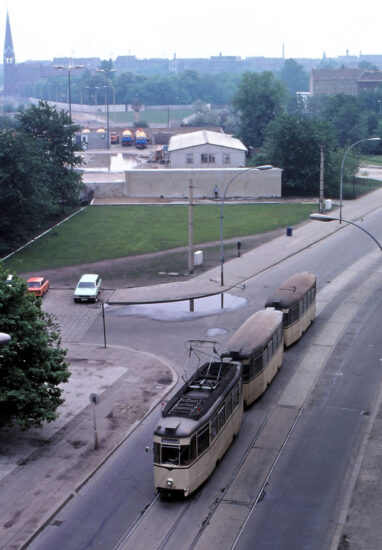For the month of May we are going east, and across the Berlin Wall, as we feature a small selection of photos taken in East Berlin during a visit in 1979. This was still very much during the Cold War although whereas you may expect that it would be difficult to not only visit East Berlin but also to capture photos of it, that was far from the case as we see in this latest stop-off in “Around the World in Trams”.
Donald Brooks paid a visit to East Berlin in May 1979 and as he explains below there as very little problem in arranging the visit:
Even in 1979 there was no problem visiting the DDR (Deutsche Demokratische Republik/German Democratic Republic/East Germany) as a tourist. The authorities needed hard currency and tourism was one way of obtaining it, albeit in relatively small amounts. Berolina Travel was the country’s official tourist office (Reisebüro) in London and accommodation for every night of a planned visit had to be booked in advance through them, though there was only a limited number of cities where hotels would be provided. If travelling into the country by rail, all you then had to do was present your pre-booked accommodation voucher to the frontier guards on the train and a visa would be issued on the spot. This of course also had to be paid for in hard currency and a specified amount of money had to be exchanged for every night of the visit.
Because of the very low rate of car ownership, public transport in the DDR had to be good and the railways provided an excellent, if not particularly fast, network throughout the country. This was supplemented by comprehensive and exceptionally cheap urban public transport, including tramway systems in twenty-three towns and cities, along with a handful of rural lines. Taking photographs of trams – and trains – was not a problem as the DDR had plenty of local enthusiasts, with transport books and magazines widely available.
The stereotypical image of the DDR is of quite a drab country and if it could be very dull in places, this was largely caused by the pollution from burning the local brown coal or lignite to generate electricity or to power industry. Generally speaking people were helpful and friendly, if sometimes understandably cautious about being seen talking to visitors from the west.
When Germany was split into two at the start of what became known as the Cold War, trams completed disappeared from the streets of West Berlin during the 1960s. But it was a completely different story in East Berlin where a standard gauge network of 173km remained operational – this included some very long routes out to the south-east, serving Köpenick and the semi-rural area of lakes and forests beyond. East Berlin’s trams, along with the city’s buses, underground and ferries were operated by Berliner Verkehrsbetriebe or BVB. The S-Bahn remained the responsibility of the state railway or Deutsche Reichsbahn.
Service was provided by a variety of cars from German builders and from ČKD Tatra in Czechoslovakia. Plenty of four-wheeled cars remained in use, usually hauling a couple of matching trailers. Tatra cars were painted in the manufacturer’s usual red and cream colours while other cars carried a plain all-over cream livery.
Most passengers would have travelled using some sort of pass or season ticket which, in the DDR way, was supposed to be produced and held aloft on boarding the tram to demonstrate to your fellow passengers that you had authority to travel. Single tickets could also be purchased from fare boxes on board.
This image looks down upon Rekowagen 217 091-0 and two matching trailers (and who doesn’t love looking down from above on trams?!). In 1979 tram route 70 ran from Hohenschönhausen Zingster Strasse (a multi-route terminal loop to the north-east of the city, to Am Kupfergraben (a long single-track terminal loop round the streets near the River Spree by Friedrichstrasse Station in the city centre). The trio of trams are seen approaching the junction with Friedrichstrasse on an inbound working to Am Kupfergraben. The Berlin Wall is in the background, complete with its watchtowers and flanking open spaces.
The Rekowagens were two-axle cars produced between 1959 and 1975 by the Deutsche Reichsbahn’s Berlin-Schöneweide works for East Berlin and other systems in the DDR. At least in part the cars were produced using components from older trams, hence the Rekowagen name, indicating at least a degree of reconstruction. Any cars surviving by 1993 were renumbered into a four-digit sequence starting 30 or 31.


Thank you. What an atmospheric photo and an interesting commentary. Look forward to further pictures
Jonathan Jarvis
Gloucester